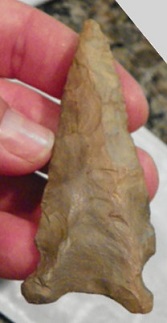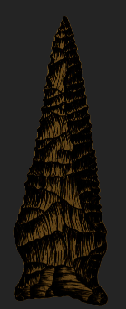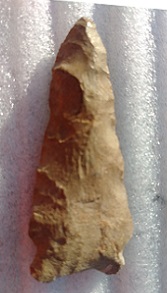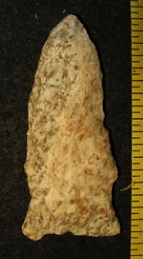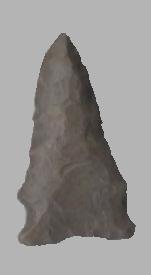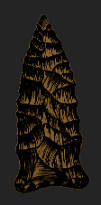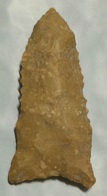Outline is Representative of Size and Shape:

Name Details:
Identified By: W. Raymond Wood from the Archaeological Workshop held at the University of Missouri. First reported by Ronald A. Thomas in 1962
Named For: Type Site
Date Identified: 1962
Type Site: Breckenridge Rock Shelter (3CR2), northwestern Arkansas
Identified By: W. Raymond Wood from the Archaeological Workshop held at the University of Missouri. First reported by Ronald A. Thomas in 1962
Named For: Type Site
Date Identified: 1962
Type Site: Breckenridge Rock Shelter (3CR2), northwestern Arkansas
Point Validity:
Valid type
Wood is a distinguished anthropologist who studied extensively in Missouri and is a professor at the University of Missouri-Columbia. This point was named in a professional publication and has many professional references. This is considered a valid type.
Wood is a distinguished anthropologist who studied extensively in Missouri and is a professor at the University of Missouri-Columbia. This point was named in a professional publication and has many professional references. This is considered a valid type.
Breckenridge Auriculate
AKA: Dalton BreckenridgeCluster: Dalton Cluster
Description of Physical Characteristics and Flaking Pattern:
This is a thin medium to large (2 3/8 to 3 ¼ inch) auriculate point with an elliptical to flattened or rhomboid cross section. The blade may vary from slightly excurvate to slightly incurvate on re-sharpened examples. The blade is commonly steeply beveled on alternating edges, commonly right-handed, but may vary to left-handed beveling, and may be serrated. Shallow and broad u-shaped notches enter low on the blade forming a shoulder are weak and at an upward angle with an expanding stem. The stem is typically short with the widest portion of the point being the base. The base is concave and rarely may have basal thinning giving the appearance of fluting, but this point is not fluted. Hafting region grinding is moderate with light basal grinding. The stem is commonly beveled opposite of the blade. The flaking pattern can vary from oblique transverse, horizontal transverse, collateral, or random.
Size Measurements:
Total Length - 60 to 83 mm (average 74 mm), Stem Length - 13 to 17 mm, Blade and Basal Width - 24 to 28 mm (average 26 mm, the blade may be wider in lightly re-sharpened examples while the base is wider in extensively re-sharpened examples), Thickness - 8 to 10 mm
Total Length - 60 to 83 mm (average 74 mm), Stem Length - 13 to 17 mm, Blade and Basal Width - 24 to 28 mm (average 26 mm, the blade may be wider in lightly re-sharpened examples while the base is wider in extensively re-sharpened examples), Thickness - 8 to 10 mm
Commonly Utilized Material:
Various non-heat treated materials.
Various non-heat treated materials.
Additional Comments:
This point is though to have evolved into the Graham Cave point (Ray and Lopinot, 2005)
This point has been credited to Ronald Thomas who completed his Masters Thesis on the Breckenridge site from the University of Missouri in 1969. He first reported this point in 1962.
This point is though to have evolved into the Graham Cave point (Ray and Lopinot, 2005)
This point has been credited to Ronald Thomas who completed his Masters Thesis on the Breckenridge site from the University of Missouri in 1969. He first reported this point in 1962.
Distribution: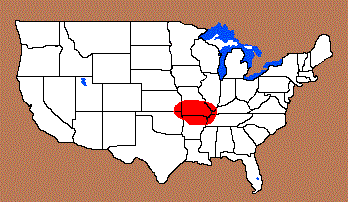
Distribution Comments:
This point is primarily found in the Ozark region of southern Missouri, northern Arkansas, northeastern Oklahoma, and into southeastern Kansas. This point may be found into the Illinois and Mississippi Alluvial Lowland region.
This point is primarily found in the Ozark region of southern Missouri, northern Arkansas, northeastern Oklahoma, and into southeastern Kansas. This point may be found into the Illinois and Mississippi Alluvial Lowland region.
Age / Periods:
Date: 10,500 - 8,500 B.P.
Cultural Period: Transition Paleo
Glacial Period: Early Holocene
Culture:
Date: 10,500 - 8,500 B.P.
Cultural Period: Transition Paleo
Glacial Period: Early Holocene
Culture:
Age Details:
There were no radio-carbon dating at the Breckenridge site, but one example was found at the Big Eddy site. Levels below had a radio-carbon dated at 9,835 +/- 70 rcybp and layers above had a radio-carbon date of 9,525 +/- 65 rcybp suggesting an age of 9,680 rcybp for that site.
There were no radio-carbon dating at the Breckenridge site, but one example was found at the Big Eddy site. Levels below had a radio-carbon dated at 9,835 +/- 70 rcybp and layers above had a radio-carbon date of 9,525 +/- 65 rcybp suggesting an age of 9,680 rcybp for that site.
Other points in this cluster / Related / Associated Points:
Beaver Lake, Dalton, Dalton Colbert, Dalton Greenbrier, Dalton Hemphill, Dalton Hempstead, Dalton Nuckolls, Dalton Sloan, Hardaway Dalton, Hi-Lo, Quad
Beaver Lake, Dalton, Dalton Colbert, Dalton Greenbrier, Dalton Hemphill, Dalton Hempstead, Dalton Nuckolls, Dalton Sloan, Hardaway Dalton, Hi-Lo, Quad

